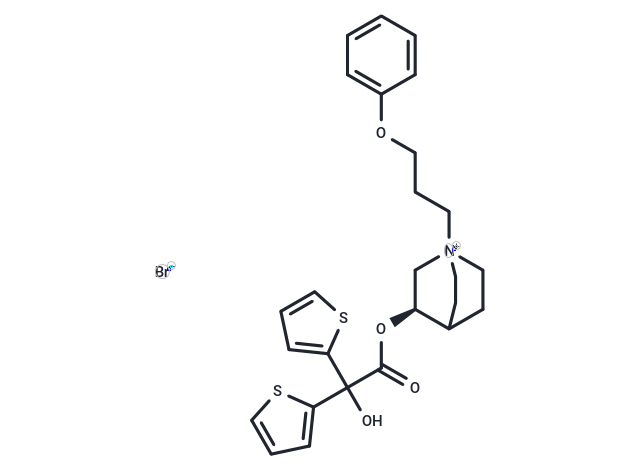Shopping Cart
- Remove All
 Your shopping cart is currently empty
Your shopping cart is currently empty

Aclidinium bromide (LAS-W 330) is a synthetic anticholinergic agent that is used as an inhalant for treatment of acute bronchospasm due to chronic bronchitis or emphysema. Aclidinium has not been implicated in causing liver enzyme elevations or clinically apparent acute liver injury.

| Pack Size | Price | Availability | Quantity |
|---|---|---|---|
| 2 mg | 31 € | In Stock | |
| 5 mg | 49 € | In Stock | |
| 10 mg | 76 € | In Stock | |
| 25 mg | 140 € | In Stock | |
| 50 mg | 233 € | In Stock | |
| 100 mg | 350 € | In Stock | |
| 500 mg | 824 € | In Stock | |
| 1 mL x 10 mM (in DMSO) | 62 € | In Stock |
| Description | Aclidinium bromide (LAS-W 330) is a synthetic anticholinergic agent that is used as an inhalant for treatment of acute bronchospasm due to chronic bronchitis or emphysema. Aclidinium has not been implicated in causing liver enzyme elevations or clinically apparent acute liver injury. |
| Targets&IC50 | M5 mAChR:0.16 nM(Ki), M1 mAChR:0.1 nM(Ki), M3 mAChR:0.14 nM(Ki), M4 mAChR:0.21 nM(Ki), M2 mAChR:0.14 nM(Ki) |
| In vitro | Aclidinium is hydrolyzed in plasma samples across all studied species at 37°C, with apparent half-lives of 11.7 minutes in rats, 38.3 minutes in guinea pigs, 1.8 minutes in dogs, and 2.4 minutes in humans. At a concentration of 0.1 μM, Aclidinium inhibits the upregulation of Type I collagen induced by acetylcholine and TGF-β1 in human bronchial fibroblasts, as well as suppressing the expression of α-SMA mRNA and protein. Additionally, 0.1 μM Aclidinium inhibits the increase in ERK1/2 phosphorylation and RhoA-GTP formation triggered by carbachol and TGF-β1 in human bronchial fibroblasts. It also represses the upregulation of ChAT expression induced by TGF-β1. A dose-dependent inhibition of TGF-β1 and carbachol-induced proliferation in human lung fibroblasts is observed with 0.1 μM Aclidinium. Concentrations below 100 nM dose-dependently inhibit carbachol-induced contraction in isolated guinea pig trachea. Pre-treatment with Aclidinium prevents the upregulation of M1 and M3 receptors in human lung fibroblasts but does not inhibit the downregulation of M2 induced by carbachol or TGF-β1. |
| In vivo | Administering 500 μg/kg of Aclidinium resulted in a maximum increase of 55% in the heart rate of conscious Beagles one hour after dosage. A concentration of 1 mg/mL of Aclidinium showed effective and sustained tracheal protection (72%–88.4%) in anesthetized guinea pigs over a study period exceeding 120 minutes. In a model of acetylcholine-induced bronchoconstriction in anesthetized guinea pigs, [3H]Aclidinium demonstrated onset of action with an IC50 (95% CI) of 140 μg/mL and a tmax of 30 minutes. |
| Kinase Assay | Affinity assay: The affinity of Aclidinium for the different human muscarinic receptor subtypes at equilibrium is determined by measuring their ability to displace the binding of [3H]NMS to cell membrane preparations expressing one of the human muscarinic receptor subtypes. Protein concentrations are 8.1 μg/well, 10.0 μg/well, 4.9 μg/well, 4.5 μg/well, and 5.0 μg/well for M1, M2, M3, M4, and M5 receptor membrane preparations, respectively. The assays are conducted at [3H]NMS concentrations approximately equal to the radioligand equilibrium dissociation constant (Kd) for the different muscarinic receptors subtypes. The [3H]NMS concentration is 0.3 nM for the M1 and M4 assays and 1 nM for the M2, M3, and M5 assays. A range of antagonist concentrations (10?14 to 10?5 M) are tested in duplicate to generate competition curves. Nonspecific binding is determined in the presence of atropine (1 μM). Assay reagents are dissolved in assay binding buffer (phosphate-buffered saline with calcium and magnesium) to a total volume of 200 μL. After a 2 hours or 6 hours incubation period (M1–M4 and M5, respectively) at room temperature in 96-well microtiter plates to ensure that equilibrium is achieved for Aclidinium, 150 μL aliquots of the reaction are transferred to GF/C filter plates pretreated for 1 hour with wash buffer (50 mM Tris, 100 mM NaCl, pH 7.4) containing 0.05% polyethylenimine. Bound and free [3H]NMS are then separated by rapid vacuum filtration followed by four washes with ice-cold wash buffer. Filters are then dried for 30 min before addition of 30 μL of OptiPhase Supermix, and radioactivity is quantified using a MicroBeta Trilux microplate scintillation counter. |
| Cell Research | Human bronchial fibroblast proliferation is measured as previously outlined by colorimetric immunoassay based on BrdU incorporation during DNA synthesis using a cell proliferation enzyme-linked immunosorbent assay BrdU kit according to the manufacturer's protocol. Cells are seeded at a density of 3x103 cells/well on 96-well plates and incubated for 24 hours. Cells are then exposed to different experimental conditions. The 490 nm absorbance is quantified using a microplate spectrophotometer. Proliferation data refers to the absorbance values of BrdU-labeled cellular DNA content per well. Stimulation is expressed as x-fold proliferation over basal growth of the untreated control set as unity.(Only for Reference) |
| Alias | LAS-W 330, LAS 34273 |
| Molecular Weight | 564.55 |
| Formula | C26H30NO4S2·Br |
| Cas No. | 320345-99-1 |
| Smiles | [Br-].OC(C(=O)O[C@H]1C[N+]2(CCCOc3ccccc3)CCC1CC2)(c1cccs1)c1cccs1 |
| Relative Density. | no data available |
| Storage | Powder: -20°C for 3 years | In solvent: -80°C for 1 year | Shipping with blue ice. | |||||||||||||||||||||||||||||||||||
| Solubility Information | H2O: < 1 mg/mL (insoluble or slightly soluble) Ethanol: < 1 mg/mL (insoluble or slightly soluble) DMSO: 104 mg/mL (184.22 mM), Sonication is recommended. | |||||||||||||||||||||||||||||||||||
Solution Preparation Table | ||||||||||||||||||||||||||||||||||||
DMSO
| ||||||||||||||||||||||||||||||||||||

Copyright © 2015-2025 TargetMol Chemicals Inc. All Rights Reserved.